The American National Standards Institute (ANSI) and Occupational Safety and Health Administration (OSHA) have developed a comprehensive collection of standards to guide the use of “safety” colors, signs, and symbols in industrial environments.
How to Apply Color Coding Standards in Industrial Settings
Painting your equipment, including machines, water lines and chemical lines, according to color coding standards allows you not only to protect your valuable assets against environmental factors but also to standardize the visual communication for statuses, cautions, hazards, etc., eliminate guesswork, simplify tasks, and improve safety and productivity by minimizing the risk of errors and workplace accidents. Below is the color coding guide for industrial applications.
SAFETY COLOR CODING
|
Color |
Description |
|
Red |
Used for the identification of fire protection equipment (e.g. sprinkler system) and dangerous/hazardous areas. |
|
Orange |
Designates the dangerous parts of machines and equipment. |
|
Yellow |
Used to mark physical hazards (e.g. risk of slipping, tripping, falling, etc.) and materials (e.g. toxic or corrosive substances, poisonous gases, etc.) potentially hazardous to life/property. |
|
Green |
Indicates First Aid equipment and materials/areas that involve no hazard to life/property. |
|
Blue |
Indicates safety information on signs and bulletin boards. |
|
Purple |
In industrial settings, purple indicates radiation hazards. |
|
Black and White |
Combinations of black and white are used to indicate trafficked areas. |
WATER LINES
|
Color |
Description |
|
Aqua |
Used to paint clarified or settled water pipes. |
|
Olive Green |
Designates raw water pipes. |
|
Dark Blue |
Indicates potable water pipe systems. |
|
Blue with Black Band |
Combination used to mark non-potable water. |
|
Blue with Red Band |
Combination that indicates water for heating buildings. |
|
Light and Medium Blue |
Used in pump stations, for pressure and section lines. |
|
Red |
Used for fire sprinkler systems. |
WASTEWATER LINES
|
Color |
Description |
|
Brown |
Indicates backwash waste and sludge. |
|
Dark Gray |
Designates the sewer system. |
|
Clay |
Used for the effluent sewage system. |
|
Brown/Black, Brown/Yellow, Brown/Orange, Brown, Orange/Red |
Color combinations used for different sludge lines. |
|
Orange/Red with Black Band |
This combination is used to indicate gas lines. |
CHEMICAL LINES
|
Color |
Description |
|
White |
Used to indicate ammonia. |
|
Black |
Designates carbon slurry systems. |
|
Yellow |
Indicates chlorine gas/solution. |
|
Yellow with Red Band |
A color combination used to designate sulfuric acid. |
|
Yellow with Orange Band |
Used to indicate ozone. |
|
Orange |
Designates alum or primary coagulants. |
|
Orange with Green Band |
Indicates coagulant aids and polymers. |
|
Yellow with Green Band |
Used to indicate caustic substances. |
|
Light Green |
Designates lime slurry systems. |
|
Light Green with Yellow Band |
Combination that indicates sulfur dioxide. |
|
Light Green with Red Band |
Indicates phosphate compounds. |
|
Light Green with Orange Band |
Used for soda ash. |
|
Light Blue with Red Band |
Designates fluoride pipe systems in industrial applications. |
|
Violet |
Used to indicate potassium permanganate lines. |
OTHER LINES
|
Color |
Description |
|
Red |
Used to paint gas pipes. |
|
Dark Green |
Indicates compressed air pipe system. |
|
Orange |
Used for steam pipes. |
|
Ivory |
Designates oil pipes. |
|
Yellow |
Used for hoists/trolleys. |
|
Light Grey |
Used to paint other pipe systems. |
In industrial environments, all pipe systems should be painted as indicated above. In addition, flow arrows must be provided on the pipes passing through the walls. In projects where just one part of the pipe system is replaced, the entire system should be painted in accordance with color coding standards. It’s also important to provide system identification labels and color bands, as required by industry regulations.
By incorporating the right colors in your industrial environment, you can enhance the appearance of your facility while increasing employee productivity and safety. To find out more about industrial painting, get in touch with our professional painters at Performance Painting by calling (904)-641-4800 or emailing info@performance-painting.com.






